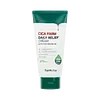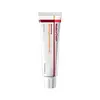What's inside
What's inside
 Key Ingredients
Key Ingredients

 Benefits
Benefits

 Concerns
Concerns

 Ingredients Side-by-side
Ingredients Side-by-side

Water
Skin ConditioningGlycerin
HumectantCaprylic/Capric Triglyceride
MaskingCentella Asiatica Leaf Extract
Skin ConditioningDipropylene Glycol
HumectantSqualane
Emollient1,2-Hexanediol
Skin ConditioningButyrospermum Parkii Butter
Skin ConditioningPolyglyceryl-3 Methylglucose Distearate
EmulsifyingOlea Europaea Fruit Oil
MaskingCetearyl Alcohol
EmollientCetearyl Olivate
Glyceryl Stearate
EmollientSorbitan Olivate
EmulsifyingCarbomer
Emulsion StabilisingTromethamine
BufferingPanthenol
Skin ConditioningButylene Glycol
HumectantParfum
MaskingXanthan Gum
EmulsifyingHelianthus Annuus Seed Oil
EmollientMadecassic Acid
Skin ConditioningAsiaticoside
AntioxidantAsiatic Acid
Skin ConditioningHoney Extract
HumectantLepidium Meyenii Root Extract
Skin ConditioningAsparagus Cochinchinensis Root Extract
Skin ConditioningAureobasidium Pullulans Ferment
Skin ConditioningNelumbium Speciosum Flower Extract
Skin ConditioningSaccharomyces Ferment
Skin ConditioningArtemisia Annua Extract
MaskingOryza Sativa Extract
AbsorbentSodium Hyaluronate
HumectantPropolis Extract
Skin ConditioningRoyal Jelly Extract
Skin ConditioningFragaria Chiloensis Fruit Extract
Skin ConditioningVaccinium Macrocarpon Fruit Extract
AstringentRubus Fruticosus Fruit Extract
AstringentVaccinium Angustifolium Fruit Extract
Skin ProtectingHydrolyzed Hyaluronic Acid
HumectantSodium Acetylated Hyaluronate
HumectantWater, Glycerin, Caprylic/Capric Triglyceride, Centella Asiatica Leaf Extract, Dipropylene Glycol, Squalane, 1,2-Hexanediol, Butyrospermum Parkii Butter, Polyglyceryl-3 Methylglucose Distearate, Olea Europaea Fruit Oil, Cetearyl Alcohol, Cetearyl Olivate, Glyceryl Stearate, Sorbitan Olivate, Carbomer, Tromethamine, Panthenol, Butylene Glycol, Parfum, Xanthan Gum, Helianthus Annuus Seed Oil, Madecassic Acid, Asiaticoside, Asiatic Acid, Honey Extract, Lepidium Meyenii Root Extract, Asparagus Cochinchinensis Root Extract, Aureobasidium Pullulans Ferment, Nelumbium Speciosum Flower Extract, Saccharomyces Ferment, Artemisia Annua Extract, Oryza Sativa Extract, Sodium Hyaluronate, Propolis Extract, Royal Jelly Extract, Fragaria Chiloensis Fruit Extract, Vaccinium Macrocarpon Fruit Extract, Rubus Fruticosus Fruit Extract, Vaccinium Angustifolium Fruit Extract, Hydrolyzed Hyaluronic Acid, Sodium Acetylated Hyaluronate
Lactis Proteinum Extract
Skin ConditioningDipropylene Glycol
HumectantHydrogenated Polydecene
EmollientCapric Acid
CleansingCaprylic/Capric Triglyceride
MaskingGlycerin
HumectantGlyceryl Stearate
EmollientPentaerythrityl Tetraethylhexanoate
EmollientNiacinamide
SmoothingCyclohexasiloxane
EmollientCetyl Alcohol
EmollientPolyglyceryl-6 Distearate
EmulsifyingWater
Skin ConditioningDicaprylyl Ether
EmollientVinyldimethicone
Asiaticoside
AntioxidantMadecassic Acid
Skin ConditioningBoric Acid
AntimicrobialMadecassoside
AntioxidantPolypeptide-1
Skin ConditioningHydrolyzed Hyaluronic Acid
HumectantMelaleuca Viminalis Extract
Inula Racemosa Root Extract
Skin ConditioningPalau White Clay Extract
HumectantMacadamia Ternifolia Seed Oil
EmollientDonkey Oil
EmollientHydrogenated Lecithin
EmulsifyingSodium Hyaluronate
HumectantPolyglyceryl-10 Laurate
Skin ConditioningStearyl Alcohol
EmollientBeeswax
Emulsion StabilisingXylitylglucoside
Humectant2-Hydroxyethyl Acrylate
Sodium Acryloyldimethyltaurate Crosspolymer
Emulsion StabilisingJojoba Esters
EmollientAnhydroxylitol
HumectantPolyglyceryl-3 Beeswax
Emulsifying1,2-Hexanediol
Skin ConditioningHydroxyacetophenone
AntioxidantXylitol
HumectantMethylpropanediol
SolventPropanediol
SolventGlucose
HumectantXanthan Gum
EmulsifyingEthoxydiglycol
HumectantDisodium Azelate
Adenosine
Skin ConditioningSorbitan Isostearate
EmulsifyingEthylhexylglycerin
Skin ConditioningSodium Laurate
CleansingCyclodextrin
AbsorbentLauric Acid
CleansingSodium Polyacrylate
AbsorbentPvp
Emulsion StabilisingPvm/Ma Copolymer
Emulsion StabilisingOctyldodecanol
EmollientGlycolide
HumectantCaffeine
Skin ConditioningC12-13 Alketh-9
EmulsifyingCollagen Amino Acids
MoisturisingCeramide EOP
Skin ConditioningResveratrol
AntioxidantArginine
MaskingGlycol
HumectantEctoin
Skin ConditioningTaurine
BufferingHydrolyzed Elastin
EmollientRetinol
Skin ConditioningMaltodextrin
AbsorbentPhytosphingosine
Skin ConditioningSucrose Stearate
EmollientSodium Dna
Skin ConditioningCyanocobalamin
Skin ConditioningGlycine
BufferingGlutamic Acid
HumectantHelianthus Annuus Seed
Skin ConditioningPolyglycerin-3
HumectantTocopherol
AntioxidantArtemisia Vulgaris Extract
Skin ConditioningVanilla Planifolia Fruit Extract
Skin ConditioningOlea Europaea Fruit Oil
MaskingOrange Roughy Oil
Skin ConditioningCitrus Aurantium Dulcis Peel Oil
MaskingLavandula Angustifolia Oil
MaskingCitrus Aurantium Bergamia Fruit Oil
MaskingRosmarinus Officinalis Leaf Oil
MaskingFruit Fly Larva Oil
EmollientCurcuma Aromatica Root Oil
Skin ConditioningAbies Balsamea Bark Oil
MaskingRosa Centifolia Flower Oil
MaskingMarmot Oil
Rosa Damascena Flower Oil
MaskingPelargonium Graveolens Oil
MaskingMyroxylon Pereirae Resin
MaskingLinalool
PerfumingLimonene
PerfumingPinus Mugo Leaf Oil
MaskingLactis Proteinum Extract, Dipropylene Glycol, Hydrogenated Polydecene, Capric Acid, Caprylic/Capric Triglyceride, Glycerin, Glyceryl Stearate, Pentaerythrityl Tetraethylhexanoate, Niacinamide, Cyclohexasiloxane, Cetyl Alcohol, Polyglyceryl-6 Distearate, Water, Dicaprylyl Ether, Vinyldimethicone, Asiaticoside, Madecassic Acid, Boric Acid, Madecassoside, Polypeptide-1, Hydrolyzed Hyaluronic Acid, Melaleuca Viminalis Extract, Inula Racemosa Root Extract, Palau White Clay Extract, Macadamia Ternifolia Seed Oil, Donkey Oil, Hydrogenated Lecithin, Sodium Hyaluronate, Polyglyceryl-10 Laurate, Stearyl Alcohol, Beeswax, Xylitylglucoside, 2-Hydroxyethyl Acrylate, Sodium Acryloyldimethyltaurate Crosspolymer, Jojoba Esters, Anhydroxylitol, Polyglyceryl-3 Beeswax, 1,2-Hexanediol, Hydroxyacetophenone, Xylitol, Methylpropanediol, Propanediol, Glucose, Xanthan Gum, Ethoxydiglycol, Disodium Azelate, Adenosine, Sorbitan Isostearate, Ethylhexylglycerin, Sodium Laurate, Cyclodextrin, Lauric Acid, Sodium Polyacrylate, Pvp, Pvm/Ma Copolymer, Octyldodecanol, Glycolide, Caffeine, C12-13 Alketh-9, Collagen Amino Acids, Ceramide EOP, Resveratrol, Arginine, Glycol, Ectoin, Taurine, Hydrolyzed Elastin, Retinol, Maltodextrin, Phytosphingosine, Sucrose Stearate, Sodium Dna, Cyanocobalamin, Glycine, Glutamic Acid, Helianthus Annuus Seed, Polyglycerin-3, Tocopherol, Artemisia Vulgaris Extract, Vanilla Planifolia Fruit Extract, Olea Europaea Fruit Oil, Orange Roughy Oil, Citrus Aurantium Dulcis Peel Oil, Lavandula Angustifolia Oil, Citrus Aurantium Bergamia Fruit Oil, Rosmarinus Officinalis Leaf Oil, Fruit Fly Larva Oil, Curcuma Aromatica Root Oil, Abies Balsamea Bark Oil, Rosa Centifolia Flower Oil, Marmot Oil, Rosa Damascena Flower Oil, Pelargonium Graveolens Oil, Myroxylon Pereirae Resin, Linalool, Limonene, Pinus Mugo Leaf Oil
Ingredients Explained
These ingredients are found in both products.
Ingredients higher up in an ingredient list are typically present in a larger amount.
1,2-Hexanediol is a synthetic liquid and another multi-functional powerhouse.
It is a:
- Humectant, drawing moisture into the skin
- Emollient, helping to soften skin
- Solvent, dispersing and stabilizing formulas
- Preservative booster, enhancing the antimicrobial activity of other preservatives
Asiaticoside comes from the super popular skin-soothing ingredient, Centella asiatica. It is one of four active compounds found in the extract of Centella Asiatica.
Asiaticoside is an antioxidant and helps with wound healing. It has been shown to increase antioxidant activity during the wound healing process.
This ingredient is an emollient, solvent, and texture enhancer. It is considered a skin-softener by helping the skin prevent moisture loss.
It helps thicken a product's formula and makes it easier to spread by dissolving clumping compounds.
Caprylic Triglyceride is made by combining glycerin with coconut oil, forming a clear liquid.
While there is an assumption Caprylic Triglyceride can clog pores due to it being derived from coconut oil, there is no research supporting this.
Learn more about Caprylic/Capric TriglycerideDipropylene Glycol is a synthetically created humectant, stabilizer, and solvent.
This ingredient helps:
Dipropylene glycol is technically an alcohol, but it belongs to the glycol family (often considered part of the ‘good’ alcohols). This means it is hydrating and gentle on skin unlike drying solvent alcohols like denatured alcohol.
As a masking agent, Dipropylene Glycol can be used to cover the smell of other ingredients. However, it does not have a scent.
Studies show Dipropylene Glycol is considered safe to use in skincare.
Learn more about Dipropylene GlycolGlycerin is already naturally found in your skin. It helps moisturize and protect your skin.
A study from 2016 found glycerin to be more effective as a humectant than AHAs and hyaluronic acid.
As a humectant, it helps the skin stay hydrated by pulling moisture to your skin. The low molecular weight of glycerin allows it to pull moisture into the deeper layers of your skin.
Hydrated skin improves your skin barrier; Your skin barrier helps protect against irritants and bacteria.
Glycerin has also been found to have antimicrobial and antiviral properties. Due to these properties, glycerin is often used in wound and burn treatments.
In cosmetics, glycerin is usually derived from plants such as soybean or palm. However, it can also be sourced from animals, such as tallow or animal fat.
This ingredient is organic, colorless, odorless, and non-toxic.
Glycerin is the name for this ingredient in American English. British English uses Glycerol/Glycerine.
Learn more about GlycerinGlyceryl Stearate is a mix of glycerin and stearic acid.
It is used to stabilize the mixing of water and oil ingredients. By preventing these ingredients from separating, it can help elongate shelf life. It can also help thicken the product's texture.
As an emollient, it helps soften skin and supports barrier-replenishing ingredients.
In cosmetics, Glyceryl Stearate is often made from vegetable oils or synthetically produced.
This ingredient may not be fungal-acne safe
Fun fact: The human body also creates Glyceryl Stearate naturally.
Learn more about Glyceryl StearateHydrolyzed Hyaluronic Acid is a form of hyaluronic acid. It is created by the hydrolysis of hyaluronic acid with a high molecular weight. Once created, Hydrolyzed Hyaluronic Acid has a low molecular weight.
Low molecular weight HA has been shown to hydrate and increase elasticity of the skin. Increasing elasticity is also associated with reduction of wrinkle depth.
One study found topical low molecular weight hyaluronic acid may be considered for the treatment of rosacea in the adult population. However, we always recommend speaking with a professional about your skin concerns.
Hyaluronic acids are a humectant. This means they draw moisture from the air. Hyaluronic acids help moisturize, soothe, and protect the skin.
Read more about other common forms of hyaluronic acid:
Learn more about Hydrolyzed Hyaluronic AcidMadecassic Acid is a major component of Centella Asiatica Extract. It has anti-inflammatory and antioxidant properties.
It is a triterpenoid, meaning it naturally acts as an antioxidant. Antioxidants protect your skin against damage from environmental factors such as pollution and UV.
Studies show Madecassic Acid helps soothe the skin due to its ability to block inflammation pathways.
Learn more about Madecassic AcidOlea Europaea Fruit Oil is the fixed oil obtained from the ripe fruit of the Olive. In other words - olive oil.
The primary contents of olive oil are glycerides of the fatty acids linoleic, oleic and palmitic.
Olive oil also contains antioxidants such as Vitamin E. Antioxidants may help reduce signs of aging by fighting unstable free-radical molecules. It also contains Vitamins A (retinol), D, and K.
The squalene in olive oil makes it a great emollient. Emollients help soothe and soften your skin by trapping moisture in. This makes olive oil a great skin moisturizer.
Studies show olive oil to have antibacterial and antifungal properties in low concentrations. Another study found olive oil irritated sensitive oily skin. We always recommend speaking with a professional about using this ingredient in your routine.
Due to the fatty acid content, this ingredient may not be fungal-acne safe.
Learn more about Olea Europaea Fruit OilSodium Hyaluronate is hyaluronic acid's salt form. It is commonly derived from the sodium salt of hyaluronic acid.
Like hyaluronic acid, it is great at holding water and acts as a humectant. This makes it a great skin hydrating ingredient.
Sodium Hyaluronate is naturally occurring in our bodies and is mostly found in eye fluid and joints.
These are some other common types of Hyaluronic Acid:
Learn more about Sodium HyaluronateWater. It's the most common cosmetic ingredient of all. You'll usually see it at the top of ingredient lists, meaning that it makes up the largest part of the product.
So why is it so popular? Water most often acts as a solvent - this means that it helps dissolve other ingredients into the formulation.
You'll also recognize water as that liquid we all need to stay alive. If you see this, drink a glass of water. Stay hydrated!
Learn more about WaterXanthan gum is used as a stabilizer and thickener within cosmetic products. It helps give products a sticky, thick feeling - preventing them from being too runny.
On the technical side of things, xanthan gum is a polysaccharide - a combination consisting of multiple sugar molecules bonded together.
Xanthan gum is a pretty common and great ingredient. It is a natural, non-toxic, non-irritating ingredient that is also commonly used in food products.
Learn more about Xanthan Gum